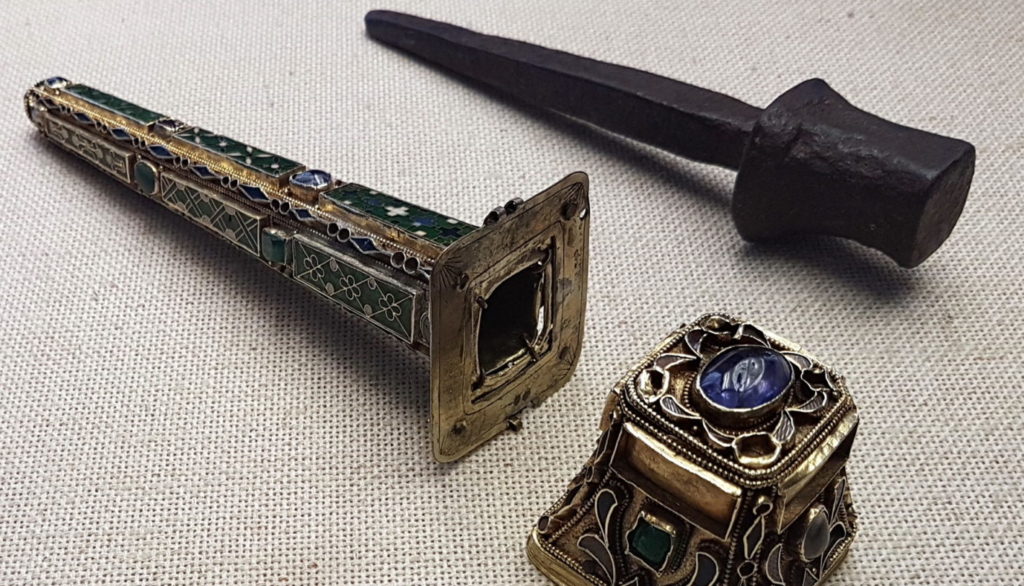We know from historical sources that nails were used in the passion of those condemned to death by crucifixion during the Roman domination of many territories.
They were used to nail Jesus Christ, and because they were "blessed" by his blood, they have always deserved great veneration. When he was taken down from the Cross after his death, according to tradition the nails were buried with it. At the beginning of the fourth century, during her journey to the Holy Land, the Empress Helena took care of recovering the relics of the Passion of the Lord, among which were the holy nails.
Elena would send part of the Cross to her son Constantine, as well as two of the three nails, which she would destine to the bit of her son's horse, his helmet and his shield, so that the emperor would be protected in his battles. The third was to be taken to Rome.
The first written reference to the existence of these relics dates back to the end of the 4th century in a prayer attributed to St. Ambrose of Milan, and later, in the 6th century, a documentation referring to the veneration of some sacred nails was found in Constantinople.
There are certain historiographical traces of various destinations of the three nails. Among them is Santa Maria della Scala in Siena, one of the largest and oldest hospitals in Europe, which in the mid-fourteenth century became a center of pilgrimages, precisely because it had one of the holy nails.
Another nail, as we were saying, was destined by St. Helena for her son, and in Milan the bit - or harness - with the holy relic is preserved. St. Charles Borromeo, archbishop of Milan, in the 16th century used the relic for processions with the faithful of the city, making them partakers of this great treasure. In Milan, every September 14, since time immemorial, the relic is exposed and venerated in the cathedral to celebrate the feast of the exaltation of the Holy Cross.
Various examples or versions of sacred nails
There are many places around the world that claim the authenticity of relics made from parts of the sacred nails incorporated into reliquaries. However, given such a large number, some of these relics could well come from the structure of the Cross itself, and not from the nails.
Relics made from their contact with the holy nails were also distributed, as distinct from incorporating - fusing - samples of them to other instruments that would in fact serve as reliquaries. Consequently, although a certain number of the holy nails may not be authentic, it could be admitted that some reliquaries, or relics properly speaking, contained some particles of the original holy nails. But it seems impossible to know which nails contain those particles of the one Elena took to Rome.
As we said, it is confirmed by the oldest sources that St. Helena found three crosses and three nails. Although it was certainly possible that more than three nails were unearthed, counting those used to crucify the two thieves, those that joined the two crossbeams of the cross or those that fixed the titulus on the top of the cross.
Many scientists, particularly archaeologists, have studied the authenticity of the various versions of sacred nails that we have, based on research about the common use that would be given at the time of Christ to the nails for the crucifixion of the condemned. Thus, by concluding what the size of the nails had to be in order to be able to pierce hands and feet, for example, their authenticity could be determined or not.
We will now list some of the places where nails -or pieces of them- are preserved, venerated as those used in the crucifixion of Christ, although, as we have pointed out, their authenticity is uncertain:
- Milan Cathedral (in the shape of a bite or harness, as mentioned above).
- Basilica of the Holy Cross of Jerusalem in Rome.
- Bamberg Cathedral, Germany.
- Cathedral of Colle di Val d'Elsa, near Siena.
- Cathedral of Notre-Dame de Paris.
- Cathedral of Saint-Etienne de Toul.
- Cathedral of Monza (iron crown).
- Vienna's Hofburg Imperial Palace (sacred spear).
- Monastery of San Nicolò l'Arena in Catania.
- Cathedral of Trier (treasure).








